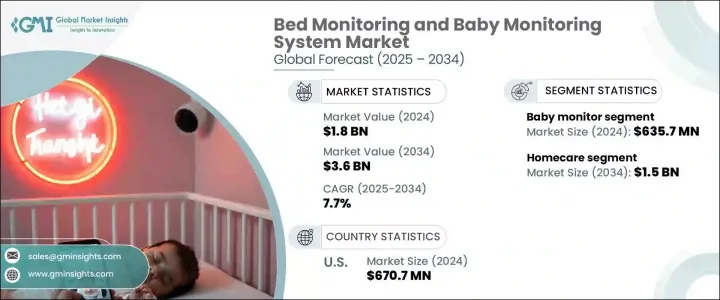
|
시장보고서
상품코드
1685146
침대 모니터링 및 아기 모니터링 시스템 시장 기회, 성장 촉진요인, 산업 동향 분석, 예측(2025-2034년)Bed Monitoring and Baby Monitoring System Market Opportunity, Growth Drivers, Industry Trend Analysis, and Forecast 2025 - 2034 |
||||||
세계의 침대 모니터링 및 아기 모니터링 시스템 시장은 2024년에 18억 달러에 이르렀으며, 2025년부터 2034년까지의 CAGR은 7.7%를 나타낼 것으로 예측되어 강력한 성장을 이룰 것으로 보입니다.
시장 확대의 배경에는 급속한 기술 진보, 환자의 안전과 안락함에 중점을 두고 예방 건강 관리에 중점을 두는 등 몇 가지 요인이 있습니다. 선진 경제 국가와 신흥 경제 국가 모두에서 건강 관리 지출이 증가함에 따라 혁신적인 모니터링 시스템에 대한 수요가 급증하고 있습니다. 이러한 시스템은 건강 지표를 실시간으로 모니터링하여 치료 결과 개선, 의료비 절감, 전반적인 의료 품질 향상을 실현합니다. 의료 제공자와 개인은 효율적이고 비용 효율적인 솔루션을 찾고 있으며 이러한 시스템을 점점 더 활용하고 있습니다. 무선 연결, 인공지능(AI), 비침습성 센서 등의 기술 혁신으로 의료 시설이나 가정에서의 침대 모니터링과 아기 모니터링 시스템의 도입이 더욱 가속화되고 있습니다. 재택 모니터링과 원격 환자 관리로의 전환은 특히 더 많은 개인들이 편안한 가정에서의 건강 관리를 선호하게 되어 건강 관리 제공의 미래를 형성하고 있습니다.

침대 모니터링 및 아기 모니터링 시스템 시장은 아기 모니터, 노인 모니터, 수면 모니터, 욕창 모니터 등 주요 카테고리를 포함한 제품 유형별로 구분됩니다. 아기 모니터 분야는 2024년에 6억 3,570만 달러가 되어 현저한 성장을 이루었습니다. 부모는 특히 수면 중 유아의 건강과 안전을 파악하는 것의 중요성을 인식하고 있습니다. 아기 모니터는 부모가 아기의 움직임, 수면 패턴 및 전반적인 건강 상태를 원격으로 모니터링 할 수 있게 함으로써 안정감을 제공합니다.
| 시장 범위 | |
|---|---|
| 시작 연도 | 2024년 |
| 예측 연도 | 2025-2034년 |
| 시작 금액 | 18억 달러 |
| 예측 금액 | 36억 달러 |
| CAGR | 7.7% |
최종 용도의 관점에서 시장은 홈케어, 병원, 간호 시설 및 기타 헬스케어 시설로 나뉩니다. 홈케어 분야는 2024년에 15억 달러를 창출했고 예측 기간을 통해 확대가 계속될 것으로 예상됩니다. 이는 기존의 병원 기반 케어에서 보다 비용 효율적인 환자 중심의 홈케어로 전환하는 경향이 커지고 있음을 반영합니다. 활력 징후, 행동 및 수면 패턴을 추적하는 모니터링 시스템의 진보로 홈 케어 솔루션은 만성 질환 관리 및 병원 외부의 수술 후 관리에 점점 더 빠져 나가고 있습니다.
미국의 침대 모니터링 및 아기 모니터링 시스템 시장은 2024년에 6억 7,070만 달러를 창출했고 2025년부터 2034년까지 연평균 복합 성장률(CAGR) 7%를 나타낼 것으로 예측됩니다. 미국에서는 고령화가 진행되고 있어 심혈관 질환이나 치매 등의 만성 질환 때문에 지속적인 모니터링이 필요한 노인이 많기 때문입니다. 노인 인구가 계속 증가함에 따라 여러 만성 건강 과제에 직면한 노인들에게 지속적인 원격 관리를 제공하는 고도 모니터링 시스템의 필요성도 커지고 있습니다.
목차
제1장 조사 방법과 조사 범위
제2장 주요 요약
제3장 업계 인사이트
- 생태계 분석
- 업계에 미치는 영향요인
- 성장 촉진요인
- 눈에 띄지 않는 모니터링 솔루션의 채용 확대
- 원내 감염 증가
- 재택 헬스케어와 원격 모니터링의 급증
- 수면장애 증가
- 업계의 잠재적 위험 및 과제
- 모니터링 시스템에 대한 높은 비용
- 데이터 보안 및 오용에 대한 개인정보 보호 우려
- 성장 촉진요인
- 성장 가능성 분석
- 규제 상황
- 기술 상황
- 가격 분석
- Porter's Five Forces 분석
- PESTEL 분석
- 갭 분석
- 밸류체인 분석
제4장 경쟁 구도
- 서론
- 기업 매트릭스 분석
- 기업 점유율 분석
- 주요 시장 기업의 경쟁 분석
- 경쟁 포지셔닝 매트릭스
- 전략 대시보드
제5장 시장 추계·예측 : 제품 유형별(2021-2034년)
- 주요 동향
- 아기 모니터
- 센서
- 웨어러블
- 노인 모니터
- 수면 모니터
- 욕창 모니터
제6장 시장 추계·예측 : 최종 용도별(2021-2034년)
- 주요 동향
- 홈케어
- 병원
- 요양원 및 요양 시설
- 기타 최종 사용자
제7장 시장 추계·예측 : 지역별(2021-2034년)
- 주요 동향
- 북미
- 미국
- 캐나다
- 유럽
- 독일
- 영국
- 프랑스
- 스페인
- 이탈리아
- 네덜란드
- 아시아태평양
- 중국
- 일본
- 인도
- 호주
- 한국
- 라틴아메리카
- 브라질
- 멕시코
- 아르헨티나
- 중동 및 아프리카
- 남아프리카
- 사우디아라비아
- 아랍에미리트(UAE)
제8장 기업 프로파일
- BLT BIOLIGHT
- EMFIT
- FOSCAM
- hisense Health Monitoring Technologies
- iBaby
- Infant Optics
- Levana
- LOREX
- motorola
- nanit
- PHILIPS
- SMART CAREGIVER
- Tekscan
- vtech
- wellsense
The Global Bed Monitoring And Baby Monitoring System Market reached USD 1.8 billion in 2024 and is set to experience robust growth, with a projected CAGR of 7.7% from 2025 to 2034. The market expansion is driven by several factors, including rapid technological advancements, an increasing focus on patient safety and comfort, and a growing emphasis on preventive healthcare. As healthcare expenditures rise in both developed and emerging economies, demand for innovative monitoring systems is surging. These systems offer real-time monitoring of health metrics, improving treatment outcomes, reducing healthcare costs, and enhancing the overall quality of care. Healthcare providers and individuals are increasingly turning to these systems as they seek efficient, cost-effective solutions. Innovations such as wireless connectivity, artificial intelligence (AI), and non-invasive sensors are further accelerating the adoption of bed monitoring and baby monitoring systems across healthcare facilities and even home settings. This shift toward at-home monitoring and remote patient care is shaping the future of healthcare delivery, particularly as more individuals prefer managing their health from the comfort of their homes.

The bed monitoring and baby monitoring system market is segmented by product type, with key categories including baby monitors, elderly monitors, sleep monitors, and pressure ulcer monitors. The baby monitor segment, valued at USD 635.7 million in 2024, is seeing significant growth. Parents are increasingly recognizing the importance of keeping track of their infant's health and safety, especially while they sleep. Baby monitors offer peace of mind by enabling parents to monitor their baby's movements, sleep patterns, and overall well-being remotely, often during nighttime when vigilance is crucial.
| Market Scope | |
|---|---|
| Start Year | 2024 |
| Forecast Year | 2025-2034 |
| Start Value | $1.8 Billion |
| Forecast Value | $3.6 Billion |
| CAGR | 7.7% |
In terms of end-use, the market is divided into homecare, hospitals, nursing homes, and other healthcare facilities. The homecare segment generated USD 1.5 billion in 2024 and is expected to continue expanding throughout the forecast period. This reflects the growing trend of shifting from traditional hospital-based care to more cost-effective, patient-centric home-based care. With advancements in monitoring systems that track vital signs, movement, and sleep patterns, homecare solutions are increasingly vital for managing chronic conditions and post-operative care outside of hospital settings.
In the U.S., the bed monitoring and baby monitoring system market generated USD 670.7 million in 2024 and is anticipated to grow at a CAGR of 7% from 2025 to 2034. The aging population in the U.S. plays a significant role in driving this demand, as a large number of elderly individuals require continuous monitoring due to chronic conditions like cardiovascular diseases and dementia. As the elderly population continues to grow, so too does the need for advanced monitoring systems that provide continuous, remote care for older adults facing multiple chronic health challenges.
Table of Contents
Chapter 1 Methodology and Scope
- 1.1 Market scope and definitions
- 1.2 Research design
- 1.2.1 Research approach
- 1.2.2 Data collection methods
- 1.3 Base estimates and calculations
- 1.3.1 Base year calculation
- 1.3.2 Key trends for market estimation
- 1.4 Forecast model
- 1.5 Primary research and validation
- 1.5.1 Primary sources
- 1.5.2 Data mining sources
Chapter 2 Executive Summary
- 2.1 Industry 3600 synopsis
Chapter 3 Industry Insights
- 3.1 Industry ecosystem analysis
- 3.2 Industry impact forces
- 3.2.1 Growth drivers
- 3.2.1.1 Growing adoption of unobtrusive monitoring solutions
- 3.2.1.2 Increasing prevalence of hospital acquired infections
- 3.2.1.3 Surge in home healthcare and remote monitoring
- 3.2.1.4 Rising incidence of sleep disorders
- 3.2.2 Industry pitfalls and challenges
- 3.2.2.1 High cost associated with monitoring systems
- 3.2.2.2 Privacy concerns about data security and misuse
- 3.2.1 Growth drivers
- 3.3 Growth potential analysis
- 3.4 Regulatory landscape
- 3.5 Technology landscape
- 3.6 Pricing analysis
- 3.7 Porter’s analysis
- 3.8 PESTEL analysis
- 3.9 Gap analysis
- 3.10 Value chain analysis
Chapter 4 Competitive Landscape, 2024
- 4.1 Introduction
- 4.2 Company matrix analysis
- 4.3 Company market share analysis
- 4.4 Competitive analysis of major market players
- 4.5 Competitive positioning matrix
- 4.6 Strategy dashboard
Chapter 5 Market Estimates and Forecast, By Product Type, 2021 — 2034 ($ Mn)
- 5.1 Key trends
- 5.2 Baby monitor
- 5.2.1 Sensors
- 5.2.2 Wearables
- 5.3 Elderly monitor
- 5.4 Sleep monitor
- 5.5 Pressure ulcer monitor
Chapter 6 Market Estimates and Forecast, By End Use, 2021 — 2034 ($ Mn)
- 6.1 Key trends
- 6.2 Homecare
- 6.3 Hospitals
- 6.4 Nursing home & assisted living facilities
- 6.5 Other end users
Chapter 7 Market Estimates and Forecast, By Region, 2021 — 2034 ($ Mn)
- 7.1 Key trends
- 7.2 North America
- 7.2.1 U.S.
- 7.2.2 Canada
- 7.3 Europe
- 7.3.1 Germany
- 7.3.2 UK
- 7.3.3 France
- 7.3.4 Spain
- 7.3.5 Italy
- 7.3.6 Netherlands
- 7.4 Asia Pacific
- 7.4.1 China
- 7.4.2 Japan
- 7.4.3 India
- 7.4.4 Australia
- 7.4.5 South Korea
- 7.5 Latin America
- 7.5.1 Brazil
- 7.5.2 Mexico
- 7.5.3 Argentina
- 7.6 Middle East and Africa
- 7.6.1 South Africa
- 7.6.2 Saudi Arabia
- 7.6.3 UAE
Chapter 8 Company Profiles
- 8.1 BLT BIOLIGHT
- 8.2 EMFIT
- 8.3 FOSCAM
- 8.4 hisense Health Monitoring Technologies
- 8.5 iBaby
- 8.6 Infant Optics
- 8.7 Levana
- 8.8 LOREX
- 8.9 motorola
- 8.10 nanit
- 8.11 PHILIPS
- 8.12 SMART CAREGIVER
- 8.13 Tekscan
- 8.14 vtech
- 8.15 wellsense












